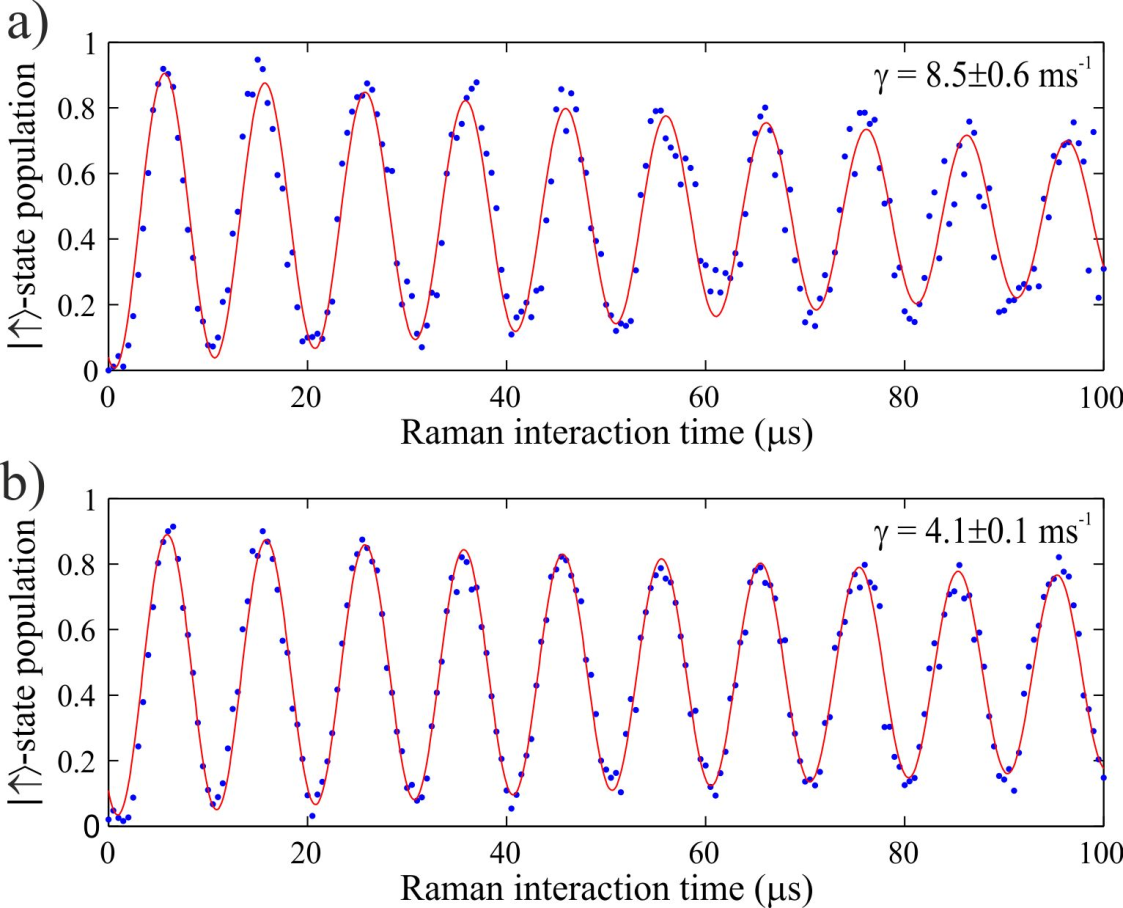News from the lab
Polarizability measurement paper published in Physical Review Letters
22nd February 2024
Our paper on measuring polarizability ratios using quantum-logic techniques has been published in Physical Review Letters.
We present a novel technique that has the potential to enhance the accuracy of cutting-edge optical ion clocks. Optical ion clocks, capable of precise timekeeping and testing of fundamental physics, face challenges due to errors in their measurements stemming from uncertainties in blackbody radiation shifts caused by limited knowledge of the clock states polarizabilities. The conventional methods to determine these polarizabilities in ion optical clocks have limitations, leading to uncertainties at the permille or percent scale. However, the proposed technique adapts the idea of measuring polarizability ratios between two different ionic species allowing to transfer the accuracy from one ion species to the other. The specific protocol, which is based on quantum-logic techniques goes beyond previously proposed schemes by allowing to use the helium ion as a reference, for which polarizabilities can be computed with exceptional precision at the 10-12 level . This innovative approach promises to significantly enhance the accuracy of polarizability measurements, representing a major stride forward in the field.
You can find the publication here: F. Wolf, PRL 132, 083202 (2024)
Oxygen quantum logic spectroscopy paper published in NJP
16th January 2024
Our paper on quantum logic spectroscopy of molecular oxygen ions has been published in New Journal of Physics.
In the paper we propose a measurement protocol, that will allow to perform precision spectroscopy on single molecular oxygen ions to probe for a possible variation of the proton-to-electron mass ratio.
You can find the publication here: F. Wolf et al., New Journal of Physics 26 (1), 013028 (2024)
Photodissociation of 24MgH+
20th September 2023
We have observed photodissociation of 24MgH+ by our 532nm Raman quantum-logic laser. This renders more complex experiments with the current logic laser infeasible. To address this issue, we are in the process of replacing the existing quantum logic laser with an infrared laser at 1120nm.

Successful production of 24MgH+
25th July 2023
We have successfully prepared a two-ion crystal consisting of a single 40Ca+ logic ion and a single 24MgH+.
The system is now ready for first tests of molecular quantum logic.
First molecular ions produced in new chamber
22th September 2022
We have produced the first molecular ions in our new experimental setup. For this purpose, we have loaded a Coulomb crystal of calcium ions and heated our getter pump to release hydrogen. The reaction of calcium with hydrogen to form calcium-hydride can be detected by the emergence of dark ions on the radial edge of the crystal. We can reduce the larger two-species crystal to a two ion mixed species crystal by subsequently splitting the ion chain and dumping the unwanted side.
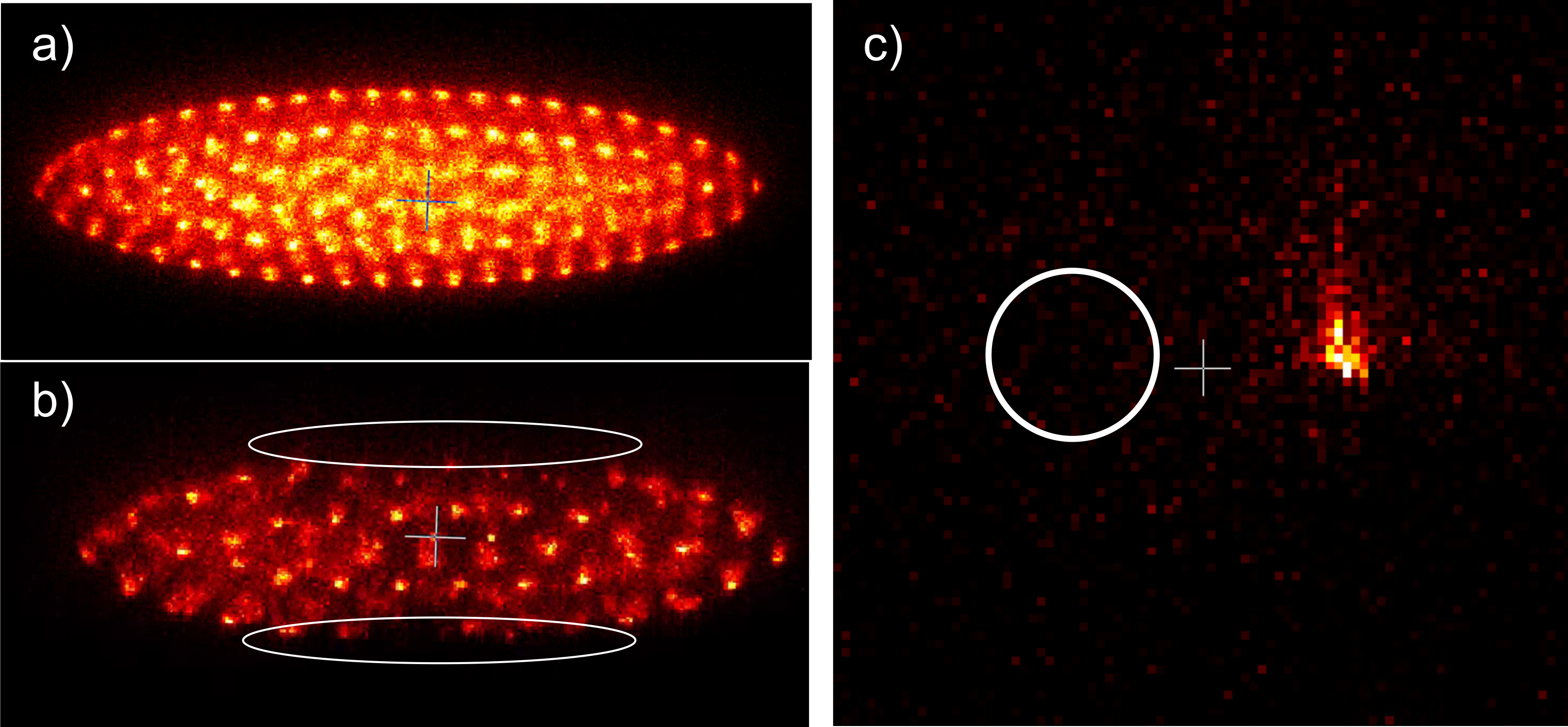
Coherent excitation by far detuned Raman interaction
We have succeeded in driving coherent population transfer between transitions of our optical qubit in the calcium ion using a far detuned optical Raman laser system with >100THz detuning. Furthermore, we succeeded in exciting individual modes of motion of the trapped ion. The latter represents a key tool for molecular ion quantum logic spectroscopy. Also, non-classical states can be generated in this way, where the internal (electronic) state is entangled with external (motional) states.
Ground state cooling of Calcium Ions
We used Electromagnetically Induced Transparency (EIT)- cooling to achieve a mean motional excitation of 0.1 phonons. In our experiment it is a two-stage process. One set of parameters provides very rapid cooling and another, second parameter set is optimized for lowers final temperatures. The cooling performance was evaluated by probing motional sideband transitions on Calcium’s optical qubit, using a high stable laser at 729nm.
With ground state cooled Ca ions and full qubit control, we can now push for mixed species ion crystal control and quantum logic protocols.
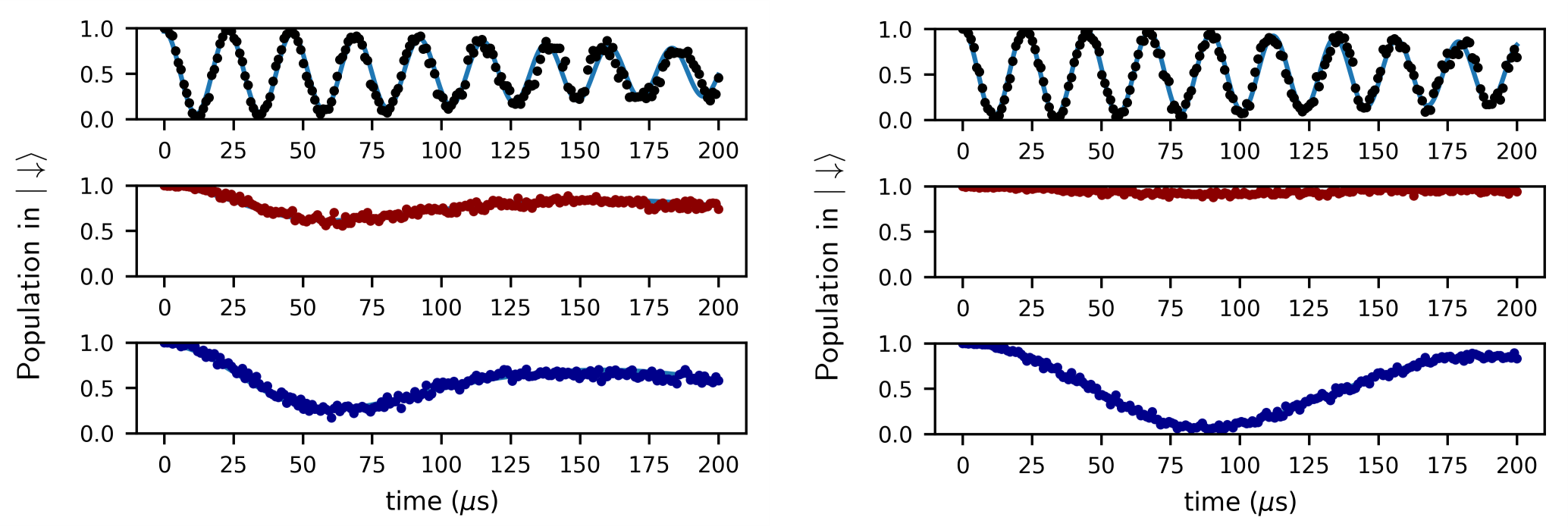
Scheme for quantum-logic spectroscopy of oxygen ions
We have theoretically investigated a scheme for quantum logic spectroscopy of molecular oxygen ions. Similar to the scheme, developed by the NIST group for CaH, we propose to use a far detuned Raman laser system. In contrast to the NIST scheme (Chou et al. Naturevolume 545, 203–207 (2017)), we plan to use bichromatic laser interactions and resolve the rotational state dependent Zeeman structure for state discrimination. We have further investigated the direct quadrupole excitation of vibrational overtones and compared the result to the two-photon dipole excitation proposed by Carrollo et al. Atoms7, 1 (2018).
The results of our investigation can be found in Wolf et al. Prospect for precision quantum logic spectroscopy of vibrational overtone transitions in molecular oxygen ions arxiv:2002:05584 (2020)

First calcium ions trapped in new ion trap
For the first time, we have succeeded in trapping calcium ions in the ion trap of our new experimental setup for spectroscopy of molecular ions. In the future, the calcium ions will take the role of the logic ion in our quantum logic experiments. The linear Paul trap used for our experiments is similar to the one operated by the highly charged ion experiment in our group and has several segments. This segmented trap type allows a much more flexible setting of the trapping potential for the controlled preparation of mixed species two-ion crystals.
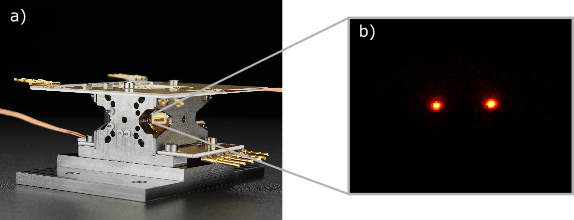
Fock state metrology
In a collaboration with Klemens Hammerer’s and Augusto Smerzi’s group, we have demonstrated that excited Fock states can be used for quantum enhanced sensing of amplitude and phase. In contrast to Squeezed states or Schrödinger cat states, the same quantum state can be used to achieve sub-Standard-Quantum-Limit sensitivity in botch quadratures. The results of our study are published in Wolf et al. Motional Fock states for quantum-enhanced amplitude and phase measurements with trapped ions, Nature Communications 10, 2929 (2019)
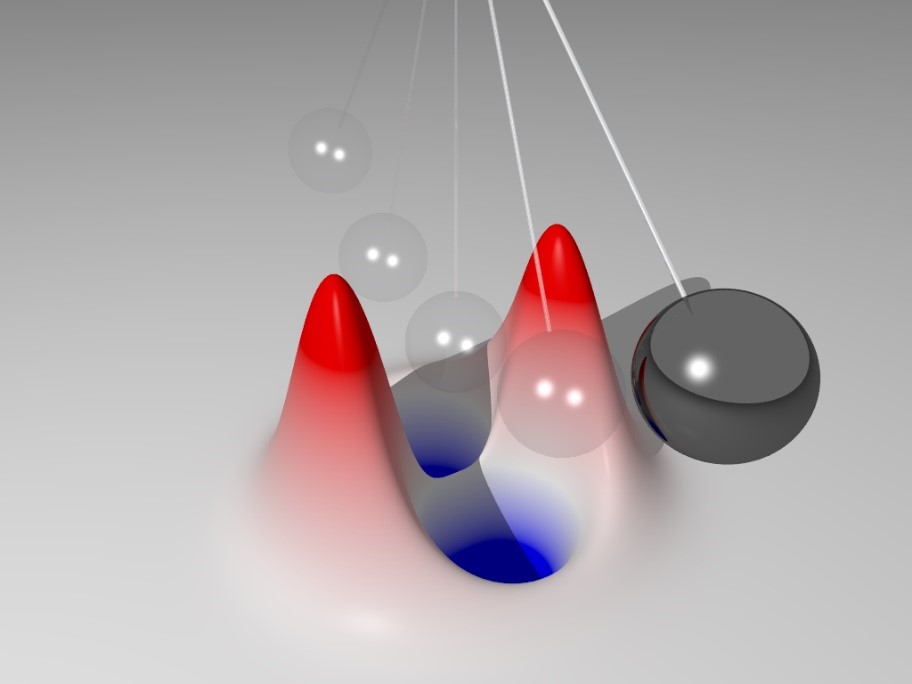
Quantum logic assisted state detection for molecular ions
High precision spectroscopy of molecular ions is still an outstanding goal that would enable tests of fundamental physics, such as searches for an electric dipole moment of the electron or probes for a variation of fundamental constants. One major problem limiting the achievable resolution was the lack of state detection techniques that allow efficient state readout without destroying the molecule.
Recently, we demonstrated for the first time a non-destructive state detection for a single molecular ions confined in a Paul trap. The result has now been published in Nature.
For further information see:
Journals homepage: http://nature.com/articles/doi:10.1038/nature16513
PTB press release:(english), (deutsch)
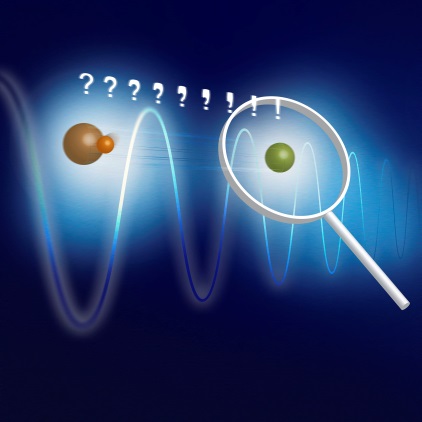
Isotope shift measurement
Journals homepage: http://journals.aps.org/prl/abstract/10.1103/PhysRevLett.115.053003
We have used photon recoil spectroscopy to measure the isotope shifts of the 2S1/2→2P1/2 and 2D3/2→2P1/2 transition for 42Ca+, 44Ca+, and 48Ca+ relative to 40Ca+ with sub-100kHz accuracy. The achieved accuracy exceeds previous measurement by an order of magnitude (see figure) and allows us to extract properties of the Ca nucleus, such as the mass shift constants, the field shift constants and the change in mean square nuclear charge radius.
Additional notes:
Two papers, recently uploaded to the arXiv use our isotope shift paper to give bounds for Higgs boson coupling
Delaunay et al. http://arxiv.org/abs/1601.05087
Delauny and Soreq http://arxiv.org/abs/1602.04838
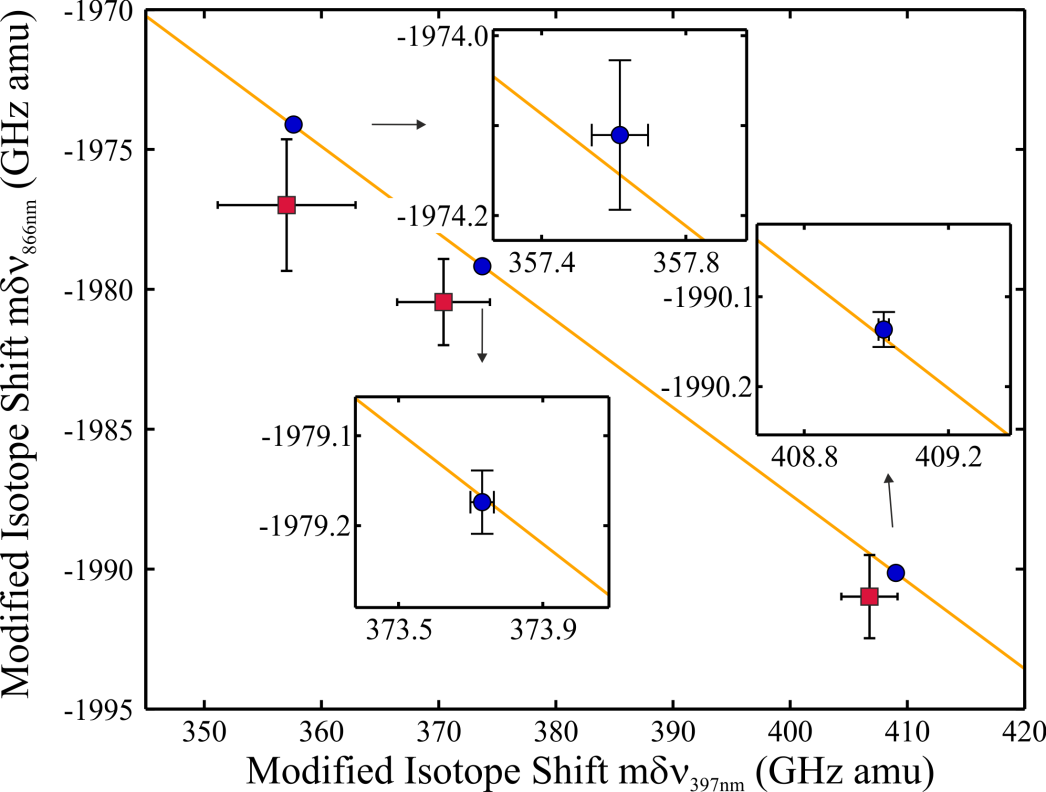
Hollow core fibers for UV light transmission
Journals homepage:
https://www.osapublishing.org/oe/abstract.cfm?uri=oe-22-13-15388
Transmission of UV light with high beam quality and pointing stability is desirable for many experiments in atomic, molecular and optical physics. In particular, laser cooling and coherent manipulation of trapped ions with transitions in the UV require stable, single-mode light delivery. Transmitting even around 2 mW CW light at 280 nm through silica solid-core fibers has previously been found to cause transmission degradation after just a few hours due to optical damage. We show that photonic crystal fiber of the kagomé type can be used for effectively single-mode transmission with acceptable loss and bending sensitivity. No transmission degradation was observed even after over 100 hours of operation with 15 mW CW input power.

A first application for the fiber was found within our optical setup, where they replaced two periscope systems that connected two stacked platforms. We achieved typically more than 50% transmission through both fibers at approximately 5 mW input power. The distance between the end of the fibers and the ion was kept as short as possible to minimize remaining pointing fluctuations from vibrations and air currents. These pointing fluctuations lead to intensity fluctuations on the ion and can limit the laser control of its internal state. The effect of beam-pointing fluctuations was investigated by driving Rabi flops of the two hyperfine states of the ion via Raman lasers. Therefore different pulse lengths of the Raman beams were applied and the excitation probability was determined by averaging over 250 repetitions per pulse length. If the position of the laser beam fluctuates, the Rabi frequency will change between single experiments. This results in a reduction of the measured Rabi oscillation contrast. Figure 1 shows the Rabi flopping curves with and without the kagomé-fiber. One can see that the contrast between the excited and the ground state decays slower when the kagomé-fiber was used.
